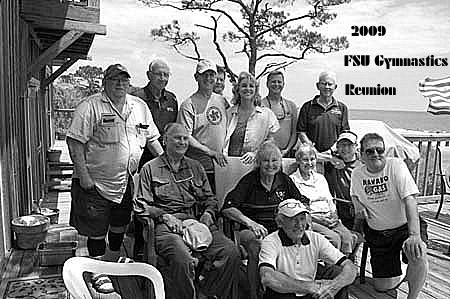Stars of Yesterday - FSU Gymnasts
By Jim Joanos
As I write this, final preparations are being made for this year's annual reunion of former Florida State University gymnasts. By the time you read it, the activities during the weekend of May 21 through 24th will have already taken place. Main headquarters for the event this year as it has been for most years is at Barbara Withers' Alligator Point house.
 |
2009 FSU Gymnastics Reunion |
Getting the former gymnasts back together periodically began rather informally or unofficially back around 1961 when following a gymnastics event on the FSU campus, a number of them met and socialized at Wakulla Springs the following day. By 1981 they had begun having "official" reunions, the first of which was organized and hosted by Jack Miles, one of the most outstanding of the former performers, in his hometown of Fort Lauderdale. The second and most of the reunions thereafter have been hosted by Withers at Alligator Point. They did go to Plant City in 2002 and in Tampa in 2003. As usually is the case, plans for this year's celebration included lots of reminiscing, visiting and other activities at several locations in Wakulla and Franklin Counties. Somewhere in the process, plans are to discuss the current project of the group to raise funds to have a commemorative statue created by famous Tallahassee sculptor (and painter) Ed Jonas, a former FSU gymnast, and placed on the FSU campus as a reminder of the great gymnasts that once performed there.
The story of men's gymnastics at FSU is a powerful one. The FSU men's gymnastics program in the short time that it existed was extremely successful. FSU, for several years, was even known as the "Gymnastics Capitol of the Nation." FSU accomplishments included five national championship teams, numerous individual national championships, and no less than 7 Olympians, 26 All-Americans, and several who represented the United States at the Pan American games.
In 1947, shortly after World War II ended, Florida State College for Women, became coeducational and renamed Florida State University. FSU took immediate steps to establish a men's intercollegiate athletics program. At some time during the first school year (1947-48), FSU's Athletic Director, Howard Danford, attended a physical education conference in Kansas City, Missouri, where he met Hartley D'Oyley Price, the gymnastics coach of the University of Illinois. Apparently, Danford was so favorably impressed by Price that shortly thereafter he asked Price to come to FSU, teach physical education and begin a gymnastics program. Surprisingly, Price accepted.
Hartley Price had been born in Brisbane, Australia in 1902, and came to the U.S. at the age of 21 to continue his education. Early in his career he had become a faculty member of the University of Illinois where in 1930, he became the head gymnastics coach. His teams at Illinois won four national collegiate, two national AAU, and five Big Ten Conference championships. However, Price's career at Illinois was interrupted by World War II. He joined the United States Navy and rose to the rank of Lieutenant Commander. When the war ended he went back to the University of Illinois and soon thereafter he accepted the job at Florida State.
There was not much to work with when Price got to Tallahassee during the 1948-49 school year. Essentially, he had to start from scratch. Several seasoned gymnasts who had earlier planned to go to the University of Illinois followed Price to FSU. The most noteworthy was William H. "Bill" Roetzheim. FSU began intercollegiate competition in men's gymnastics in 1950. In addition to competing against other colleges, that team as well as the others that followed, competed in Amateur Athletic Union events. At the time, AAU competition was tougher than that of the NCAA as it included a larger group of amateur teams and athletes.
In 1951, at a meet in Ann Arbor, Michigan, FSU 's gymnastics team won the first ever NCAA Championship by a team from the State of Florida in any sport. They also won the AAU national championship held in Detroit, Michigan that same year. In the following summer, Roetzheim represented the United States at the first Pan American Games in Buenos Aires, Argentina, where he not only won first place in the horizontal bars competition, but also won the overall gymnastics individual championship. In 1952, the FSU team repeated as NCAA national champion. That summer, FSU gymnasts Bill Roetzheim and Don Holder competed as members of the U.S. team at the Olympic Games in Helsinki, Finland.
FSU remained very competitive at the national NCAA meets through 1959. The Seminoles won two more national AAU championships in 1953 and 55. Of special note was the FSU team's competition against national teams from other countries. In 1954 in Tallahassee, FSU took on the world champion Swedish National team and defeated them. The Seminoles repeated the following year when the touring Swedish team again came back to Tallahassee. In 1956, the FSU team traveled to Havana, and beat Cuba's National team.
Athletic director Howard Danford left FSU in 1957. Danford had been a big supporter of an all-round program that placed emphasis upon a large number of sports. The athletics directors following him, faced with limited resources, cut down on the number of athletics teams to be financed at the intercollegiate level. Men's volleyball, as a varsity sport was terminated after the 1957 season. Gymnastics hung on longer because of Dr. Price's and the team's popularity but ultimately by 1961 the school had withdrawn intercollegiate financial support for the sport. For a number of years thereafter, Coach Price continued to lead the gymnastics team as a club sport. It was even expanded to include women's participation.
Price retired from FSU in 1971 and died in 1977. With Price's passing, FSU's major pioneer role in the US's collegiate men's gymnastics world ended. It may have been a short one but it was a great run!